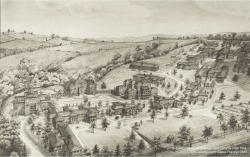St Elizabeths Hospital
| St Elizabeths Hospital | |
|---|---|
 | |
| Established | 1852 |
| Construction Began | 1855 |
| Current Status | Active |
| Building Style | Kirkbride Plan |
| Architect(s) | Thomas U. Walter; Shepley, Rutan & Coolidge |
| Location | Washington, DC |
| Architecture Style | Gothic Revival, Gothic |
| Peak Patient Population | 7,000 |
| Alternate Names | Governor Hospital for the Insane, United States Government Hospital for the Insane |
Contents
History
Established in 1855 as the Government Hospital for the Insane, St. Elizabeth's Hospital has had a distinguished history in the treatment of the mentally ill. The Hospital's early mission, as defined by its founder, the leading mental health reformer Dorothea Dix, was to provide the "most humane care and enlightened curative treatment of the insane of the Army, Navy, and District of Columbia." During the Civil War, wounded soldiers treated here were reluctant to admit that they were in an insane asylum, and said they were at St. Elizabeth's, the colonial name of the land where the Hospital is located. Congress officially changed the Hospital's name to St. Elizabeth's in 1916. By the 1940s, the Hospital complex covering an area of over 300 acres housed 7,000 patients. It was the first and only federal mental facility with a national scope.
West Campus
In 1987, the federal government transferred the hospital operations and the east hospital campus to the DC Department of Mental Health, while retaining ownership of the western campus. The western campus of St. Elizabeth's contains many historical buildings, including the original 1850s Kirkbride building, which has been designated a National Historic Landmark, but it is not in use because of its state of disrepair. There is also a Civil War cemetery where 300 Union and Confederate soldiers who died here are buried. The Hospital complex is located on a hill in southeast Washington, overlooking the Potomac and Anacostia Rivers. The western campus is property of the Federal government and is closed to the public. The historical buildings on the west campus, including the Kirkbride, were to be renovated into a new headquarters for the Dept of Homeland Security and the Coast Guard, but because of government budget cuts, nothing has materialized as of yet. Though according to one photographer that was inside the Kirkbride, some construction work has already taken place and the interior of the building is pretty gutted. An article from Feb 2008 states that the General Services Administration is seeking a funding boost to continue with the plan to turn the Kirkbride and other historical buildings into their new home.
East Campus
The eastern campus contains many newer buildings, built during the 20th century. The include many smaller two story pavilion style buildings and other large 5+ story buildings. The east campus is still an active medical center, owned by the DC Department of Mental Health. Construction began in 2006 on a new 450,000 square foot, state-of-the-art facility to replace the 150-year old Hospital. The new hospital incorporates the best practices in modern, in patient mental health care with an environmentally sensitive design and sustainable strategies. The new building’s therapeutic design includes bright and airy living and treatment areas, green spaces off each patient unit, and enclosed courtyards. A 28,000 square-foot green roof is likely the largest on any psychiatric facility in the country. The new hospital is scheduled for completion in late 2009. Follow the construction with monthly pictorial updates. In 2005, the Hospital celebrated the 150th anniversary of its founding and honored members of the Armed Forces who became mentally ill while serving their country.[1]
Images of St Elizabeths Hospital
Main Image Gallery: St Elizabeths Hospital


